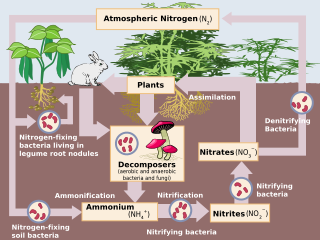
Back نزع النيتروجين Arabic Denitrifikasiya Azerbaijani Desnitrificació Catalan Denitrifikace Czech Denitrifikation Danish Denitrifikation German Desnitrificación Spanish Denitrifikatsioon Estonian Desnitrifikazio Basque Denitrifikaatio Finnish

Denitrification is a microbially facilitated process where nitrate (NO3−) is reduced and ultimately produces molecular nitrogen (N2) through a series of intermediate gaseous nitrogen oxide products. Facultative anaerobic bacteria perform denitrification as a type of respiration that reduces oxidized forms of nitrogen in response to the oxidation of an electron donor such as organic matter. The preferred nitrogen electron acceptors in order of most to least thermodynamically favorable include nitrate (NO3−), nitrite (NO2−), nitric oxide (NO), nitrous oxide (N2O) finally resulting in the production of dinitrogen (N2) completing the nitrogen cycle. Denitrifying microbes require a very low oxygen concentration of less than 10%, as well as organic C for energy. Since denitrification can remove NO3−, reducing its leaching to groundwater, it can be strategically used to treat sewage or animal residues of high nitrogen content. Denitrification can leak N2O, which is an ozone-depleting substance and a greenhouse gas that can have a considerable influence on global warming.
The process is performed primarily by heterotrophic bacteria (such as Paracoccus denitrificans and various pseudomonads),[1] although autotrophic denitrifiers have also been identified (e.g., Thiobacillus denitrificans).[2] Denitrifiers are represented in all main phylogenetic groups.[3] Generally several species of bacteria are involved in the complete reduction of nitrate to N2, and more than one enzymatic pathway has been identified in the reduction process.[4] The denitrification process does not only provide energy to the organism performing nitrate reduction to dinitrogen gas, but also some anaerobic ciliates can use denitrifying endosymbionts to gain energy similar to the use of mitochondria in oxygen respiring organisms.[5]
Direct reduction from nitrate to ammonium, a process known as dissimilatory nitrate reduction to ammonium or DNRA,[6] is also possible for organisms that have the nrf-gene.[7][8] This is less common than denitrification in most ecosystems as a means of nitrate reduction. Other genes known in microorganisms which denitrify include nir (nitrite reductase) and nos (nitrous oxide reductase) among others;[3] organisms identified as having these genes include Alcaligenes faecalis, Alcaligenes xylosoxidans, many in the genus Pseudomonas, Bradyrhizobium japonicum, and Blastobacter denitrificans.[9]
- ^ Carlson, C. A.; Ingraham, J. L. (1983). "Comparison of denitrification by Pseudomonas stutzeri, Pseudomonas aeruginosa, and Paracoccus denitrificans". Appl. Environ. Microbiol. 45 (4): 1247–1253. Bibcode:1983ApEnM..45.1247C. doi:10.1128/AEM.45.4.1247-1253.1983. PMC 242446. PMID 6407395.
- ^ Baalsrud, K.; Baalsrud, Kjellrun S. (1954). "Studies on Thiobacillus denitrificans". Archiv für Mikrobiologie. 20 (1): 34–62. doi:10.1007/BF00412265. PMID 13139524. S2CID 22428082.
- ^ a b Zumft, W G (1997). "Cell biology and molecular basis of denitrification". Microbiology and Molecular Biology Reviews. 61 (4): 533–616. doi:10.1128/mmbr.61.4.533-616.1997. PMC 232623. PMID 9409151.
- ^ Atlas, R.M., Barthas, R. Microbial Ecology: Fundamentals and Applications. 3rd Ed. Benjamin-Cummings Publishing. ISBN 0-8053-0653-6
- ^ Graf, Jon S.; Schorn, Sina; Kitzinger, Katharina; Ahmerkamp, Soeren; Woehle, Christian; Huettel, Bruno; Schubert, Carsten J.; Kuypers, Marcel M. M.; Milucka, Jana (3 March 2021). "Anaerobic endosymbiont generates energy for ciliate host by denitrification". Nature. 591 (7850): 445–450. Bibcode:2021Natur.591..445G. doi:10.1038/s41586-021-03297-6. PMC 7969357. PMID 33658719.
- ^ An, S.; Gardner, WS (2002). "Dissimilatory nitrate reduction to ammonium (DNRA) as a nitrogen link, versus denitrification as a sink in a shallow estuary (Laguna Madre/Baffin Bay, Texas)". Marine Ecology Progress Series. 237: 41–50. Bibcode:2002MEPS..237...41A. doi:10.3354/meps237041.
- ^ Kuypers, MMM; Marchant, HK; Kartal, B (2011). "The Microbial Nitrogen-Cycling Network". Nature Reviews Microbiology. 1 (1): 1–14. doi:10.1038/nrmicro.2018.9. hdl:21.11116/0000-0003-B828-1. PMID 29398704. S2CID 3948918.
- ^ Spanning, R., Delgado, M. and Richardson, D. (2005). "The Nitrogen Cycle: Denitrification and its Relationship to N2 Fixation". Nitrogen Fixation: Origins, Applications, and Research Progress. pp. 277–342. doi:10.1007/1-4020-3544-6_13. ISBN 978-1-4020-3542-5.
It is possible to encounter DNRA when your source of carbon is a fermentable substrate, as glucose, so if you wanna avoid DNRA use a non fermentable substrate
{{cite book}}: CS1 maint: multiple names: authors list (link) - ^ Liu, X.; Tiquia, S. M.; Holguin, G.; Wu, L.; Nold, S. C.; Devol, A. H.; Luo, K.; Palumbo, A. V.; Tiedje, J. M.; Zhou, J. (2003). "Molecular Diversity of Denitrifying Genes in Continental Margin Sediments within the Oxygen-Deficient Zone off the Pacific Coast of Mexico". Appl. Environ. Microbiol. 69 (6): 3549–3560. Bibcode:2003ApEnM..69.3549L. CiteSeerX 10.1.1.328.2951. doi:10.1128/aem.69.6.3549-3560.2003. PMC 161474. PMID 12788762.